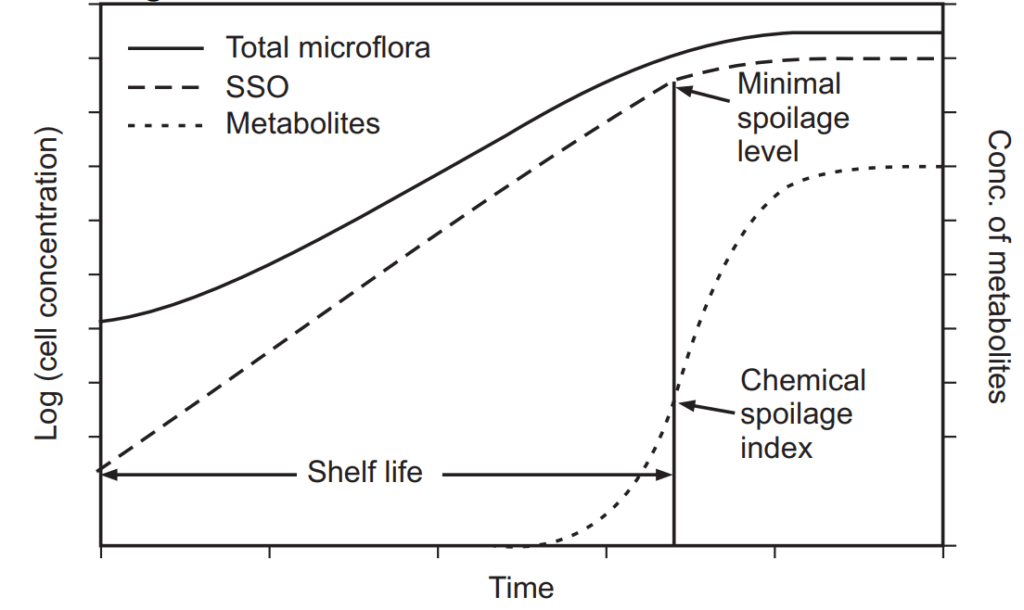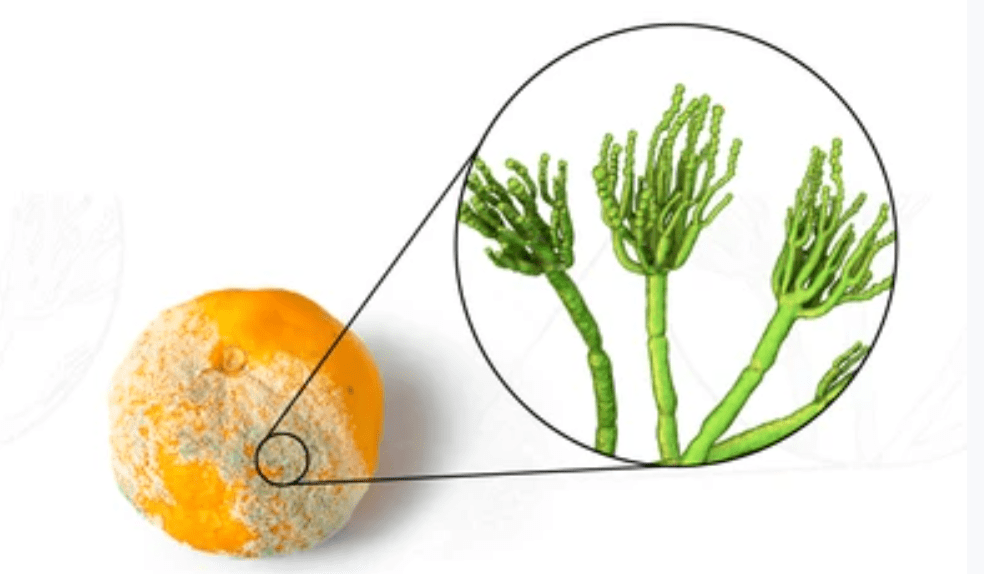Microbial Spoilage is the term that indicates the goods that do not meet production standards. It is the method by which material or the amount of material is wasted or scrapped during the manufacturing process. In another word, it is a form of substandard drug or food in which the quality or value, or usefulness of the article is destroyed or impaired by the action of microorganisms like fungi or bacteria as to render the article unfit for humans consumption. Hence, spoilage is a complex reaction in which a combination of microbial and biochemical activities are interacting. Legally they are known as spoilage. These substandard drugs when proceeding further in order to be saleable as goods units are known as defectives. Examples: Rancid meat, sour milk, moldy cheese, etc. The spoilage is mainly determined based on microbial colonization form which depends on the characteristics of products, method of processing, and the storage condition. These factors are characterized into four types viz. intrinsic parameters (physical, chemical, structural properties of foods, water activity, acidity, redox potential), extrinsic parameters (temperature, humidity, atmosphere conditions), modes of preservation and processing (physical and chemical treatments, change characteristics of food products, determination of microbial flora in food products) and implicit parameters (microbial interferences either by synergistic or antagonistic action, destruction of one organism by another species).
Table of Contents
Types of spoilage
Spoilages are mainly two types.
- Microbial spoilage and
- Non-microbial spoilage.

Microbial Spoilage
It includes the contamination of Pharmaceutical products with the microbes that lead to spoilage of the product. It affects drug safety and quality and is not intended for use. Hence, microbial spoilage is the deterioration of pharmaceutical products by the contaminant microbes such as bacteria, molds, fungi, and yeasts. The growth pattern of microbial spoilage is shown in Fig. 1.1.

SSO = Specific spoilage organisms.
Non-Microbial Spoilage
These are the chemical reactions caused by foreign material in the foodstuff or by enzymes that occur in the foodstuff naturally resulting in rancidity, staling, discoloration, drying out, or damage by the insect.
Chemical spoilage: It is based on a non-enzymatic chemical reaction that occurred within the foods and resulted from the change in flavor. Some examples are given in Table 5.1.

Enzymatic spoilage: It is based on enzymatic reactions that occurred in foods and changes in chemical nature and resulting rancidity. This rancidity occurred by two types of chemical reactions viz. hydrolytic and oxidative rancidity. For example, Triglyceride upon hydrolytic reaction in presence of lipase enzyme forms glycerol and free fatty acid. Further, Linolenic acid with various oxidative reactions forms 3-(E)-hexenal and 12-oxo-9 (Z) dodecenoic acid with the help of lipoxygenase and hydroperoxide lyase. Some examples are given in Table 1.2.

Physical spoilage: It occurs due to temperature, light, relative humidity and results in mechanical damage of the food components. For example Oxidation of food occurs due to light and changes in color, flavor, and chemical nature, like the greening of potatoes, sunlight flavor in milk, loss of vitamin D, E, etc.
Other spoilage: It occurs due to insects, rodents, birds, and other animals and results in changes in color, odor, and chemical nature.
Based on the rate of spoilage, they are classified into three types like high perishable, semi-perishable, and stable or non-perishable spoilage.
- High perishable: Meat, fish, poultry, eggs, milk, fruits, and vegetables, etc.
- Semi-perishable: Potatoes, some apple varieties, nutmeats, etc.
- Stable or non-perishable: Sugar, flour, dry beans, etc.
Spoilage of fruits and vegetables
Acid-tolerant bacteria are responsible for the spoilage of fruits and vegetables such as Lactobacillus species. Not only that deterioration is also caused by animals and birds, but wounding, cutting, freezing, environmental conditions, contact with spoiled foods, etc. also causes food spoilage. Mainly two types of spoilages are observed likely bacterial soft rot and rhizopus soft rot.
Bacterial soft rot is caused by Erwinia carotovora, ferment pectins, Pseudomonas marginalis, etc. Bacillus and Clostridium are causes for water-soaked appearance and bad odor of vegetables, black mold rot causes spotting of leaves and fruits. Rhizopus soft rot is caused by Rhizopus. Cottony growth of mold forms black spots of sporangia covering the foods. Alternaria rot is caused by Alternaria tenuis, resulting in a green-brown spot. Rots of juicy fruits result in leakage.
Spoilage of cereals
Moisture content above 12 to 13 percent causes spoilage of cereals due to the growth of molds, bacteria, and yeasts. Molds are grown in little moisture whereas in high moisture condition yeasts and bacteria grows. Aspergillus, Penicillium, Mucor, Rhizopus, Fusarium are some common molds that produce mycotoxins. Acetobacter spp., lactic and Coliforms, Micrococci, and Bacillus are some species causing spoilage of cereals.
Spoilage of milk
Souring of milk is caused by Streptococcus lactis, Enterococci, Lactobacilli, etc. Proteolysis causes a bitter taste of milk which is caused by Bacillus, Serratia, Pseudomonas, etc.
Spoilage of meat
Raw meat is spoiled by microbial as well as enzymatic action. Excessive autolysis causes souring of meat.
Spoilage of fish
Fish is spoiled by autolysis, oxidation, or by bacterial activity. Under anaerobic conditions, the surface slime of fishes is caused by Pseudomonas, Streptococcus, Micrococci, etc. Surface color changes due to pigmentation. For example, Red spot is caused by Serratia marcescens, Pseudomonas gives blue color.
Spoilage of eggs
Spoilage of eggs is promoted by cracking, improper washing, and storage. Egg yolk is a good growth medium for microorganisms due to its high nutrient. Molds that cause the spoilage of eggs are Penicillium, Mucor, Sporotrichum, etc. Spoilage of eggs is also occurred by fungi. There are two stages of egg spoilage like pin spot molding and fungal rotting.
Spoilage of canned foods
Canned foods are chemically spoiled due to hydrogen swells as a result discolouration of inside the can, cloudiness of liquors, and that affects the nutritive value of the canned foods. Due to bacterial spoilage loss of nutritive value occurs by thermophilic and mesophilic bacteria. Thermophilic anaerobes form acid and gas whereas sulfide spoilage occurs by Desulfotomaculum significantly that resulted in black colonies. Sometimes ends of can flatten due to souring caused by Bacillus stearothermophilus.
Some of the important food spoilages along with their causative microorganisms are tabulated in Table 1.3.


Make sure you also check our other amazing Article on : Microbiological assay of vitamins
